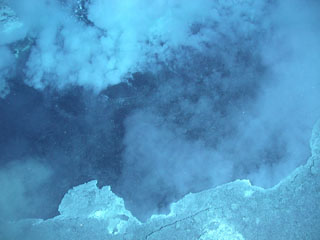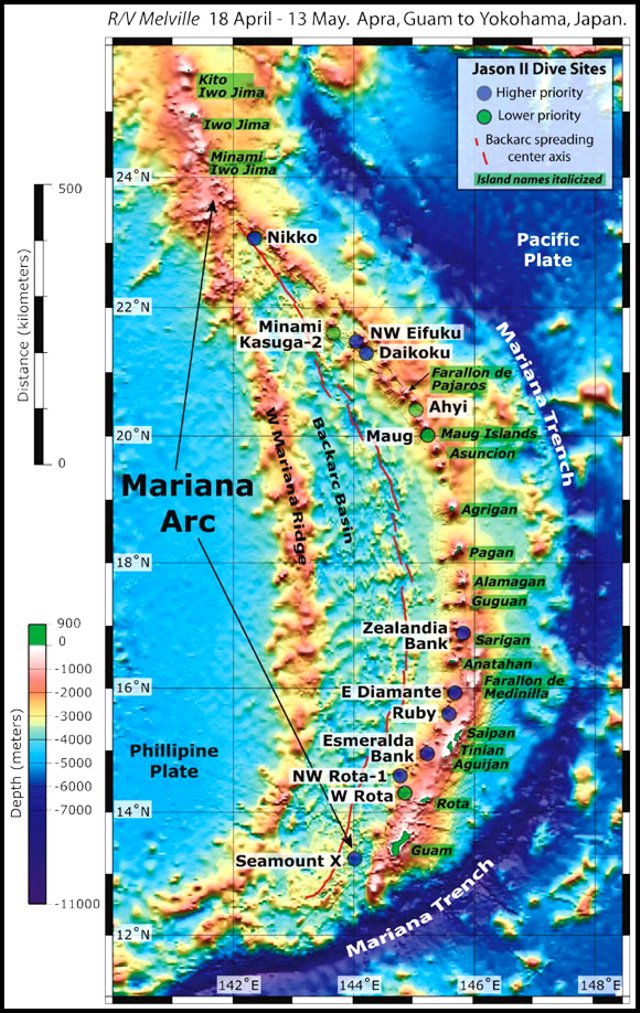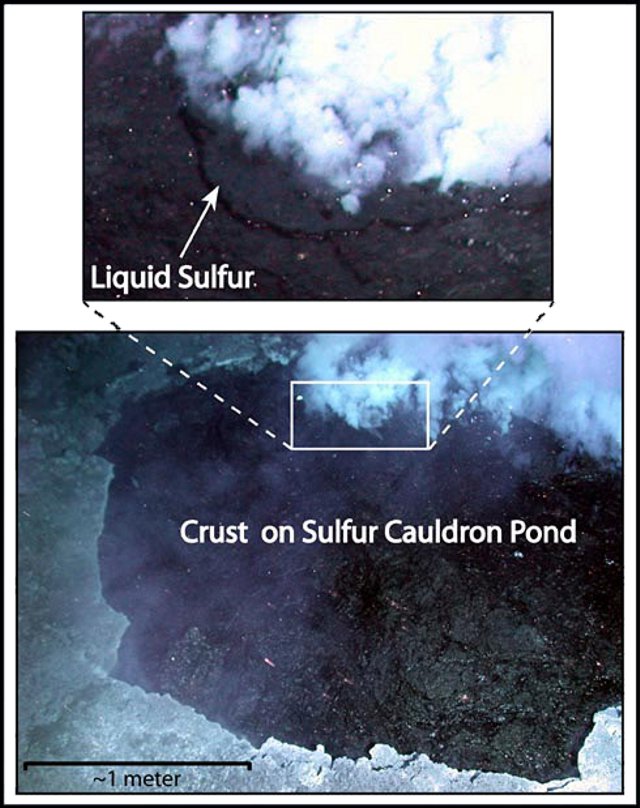Report on Daikoku (United States) — May 2006
Bulletin of the Global Volcanism Network, vol. 31, no. 5 (May 2006)
Managing Editor: Richard Wunderman.
Daikoku (United States) Discovery of agitated pool of molten sulfur at 420 m ocean depth
Please cite this report as:
Global Volcanism Program, 2006. Report on Daikoku (United States) (Wunderman, R., ed.). Bulletin of the Global Volcanism Network, 31:5. Smithsonian Institution. https://doi.org/10.5479/si.GVP.BGVN200605-284137
Daikoku
United States
21.324°N, 144.194°E; summit elev. -323 m
All times are local (unless otherwise noted)
Submarine exploration at Daikoku seamount has discovered a small pit or cauldron containing a pool of molten sulfur. During the period of 18 April-13 May 2006, scientists from the National Oceanic and Atmospheric Agency (NOAA), aboard the research vessel Melville completed the 2006 Submarine Ring of Fire Expedition. This expedition was the third in a series exploring of the submarine volcanoes lying along the Mariana arc (figure 1). The arc extends from S of the island of Guam northward more than 1,450 km. Daily logs of the 2006 expedition, including photographs and video clips, can be viewed on the NOAA Ocean Explorer website (see Information Contacts below).
William Chadwick reported on the 2006 expedition (Oregon State University press release, 25 May 2006) that ". . . on another volcano called Daikoku, in the northern part of the Mariana volcanic arc, the researchers discovered a pool of molten sulfur at a depth of 420 m. It was measured at 187°C. It was a sulfur pond with a flexible 'crust' that was moving in a wavelike motion. The movement was triggered by continuous gases being emitted from beneath the pool and passing through the sulfur." (figure 2).
In another pit on the summit of Daikoku, over 100 m deep and ~ 80 m in diameter, the scientists observed a large plume of slowly rising white fluid.
References. Embley, R.W., Baker, E.T., Chadwick, W.W., Jr., Lipton, J.E., Resing, J.A., Massoth, G.J., and Nakamura, K., 2004, Explorations of Mariana Arc volcanoes reveal new hydrothermal systems: EOS, Transactions, American Geophysical Union, v. 85, no. 2, p. 37, 40.
Embley, R.W., Chadwick, W.W., Jr, Baker, E.T., Butterfield, D.A., Resing, J.A., de Ronde, C. E.J., Tunnicliffe, V., Lupton, J.E., Juniper, S.K., Rubin, K.H., Stern, R.J., Lebon, G.T., Nakamura, K., Merle, S.G., Hein, J.R., Wiens, D.A., and Tamura, Y., 2006, Long-term eruptive activity at a submarine arc volcano: Nature, v. 441, no. 7092, p. 494-497.
Oregon State University, 25 May 2006, Press Release: Nature paper details eruption activity at submarine volcano: College of Oceanic and Atmospheric Science (COAS), 104 COAS Admininstration Building, Corvallis, OR 97331.
Geological Summary. The conical summit of Daikoku seamount lies along an E-W ridge SE of Eifuku and rises to within 323 m of the sea surface. A steep-walled, 50-m-wide crater on the N flank, about 75 m below the summit, is at least 135 m deep and was observed to emit cloudy hydrothermal fluid. During a NOAA expedition in 2006, scientists observed a convecting black pool of liquid sulfur with a partly solidified, undulating sulfur crust at a depth of 420 m below the summit. Gases, particulates with the appearance of smoke, and liquid sulfur were bubbling up from an edge of the sulfur pool.
Information Contacts: William W. Chadwick, Jr., Cooperative Institute for Marine Resources Studies (CIMRS), NOAA Pacific Marine Environmental Laboratory (PMEL), 2115 SE OSU Drive, Newport, OR 97365 USA; NOAA Ocean Explorer (URL: http://oceanexplorer.noaa.gov/explorations/06fire/welcome.html).



